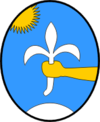Grožnjan
|
Grožnjan Grisignana |
||
|
||
|
|
||
| Basic data | ||
|---|---|---|
| State : |
|
|
| County : |
|
|
| Height : | 288 m. i. J. | |
| Area : | 68 km² | |
| Residents : | 736 (2011) | |
| Population density : | 11 inhabitants per km² | |
| Telephone code : | (+385) 052 | |
| Postal code : | 52429 | |
| License plate : | PU | |
| Structure and administration (status: 2013, cf. ) |
||
| Community type : | local community | |
| Mayor : | Claudio Stocovaz ( IDS / DDI ) | |
| Website : | ||
 View of Grožnjan |
||
Grožnjan (Italian Grisignana ) is a village and a municipality in Croatia . It is located in the Istria County . The number of inhabitants of the municipality in 2011 was around 736, with 164 living in Grožnjan itself.
languages
In the 2011 census, 39.40% of the municipality's inhabitants described themselves as ethnic Italians, 29.62% Croatians and 18.21% Istrians. 56.52% said their mother tongue was Italian , 37.36% Croatian and 2.72% Slovenian . Grožnjan / Grisignana is the only municipality in Croatia with an Italian-speaking majority.
history
Grožnjan is mentioned for the first time in 1102 as the property of the Patriarchs of Aquileia . From 1358 Grožnjan was expanded by the Venetian Republic into an important military base. At that time, Grožnjan still had direct access to the sea via the port of Baštija. Grožnjan was badly damaged during the Uskok War and became more and more insignificant after the fall of the Venetian Lion Republic in 1779. After the Second World War after 1945, Istria became part of the Yugoslav republics of Croatia and Slovenia. Since the political status of the Free Territory of Trieste was unclear until 1954, Grožnjan was in the so-called Zone B of this territory from 1947 to 1954 .
Because of the resulting exodus of the Italian-speaking residents, Grožnjan was almost deserted until the middle of the 20th century. The place even lost its status as an independent municipality and was administered from Buje from 1956 to 1993 .
The settlement achieved greater national fame because of the Grisignana marble ( limestone ) that was quarried in its wider area and is highly valued by stonemasons . This light beige limestone from the Cretaceous period found its way to Trieste , Vienna , Budapest and northern Italian cities as a very durable architectural material . The peak of its use was in the late 19th century. This rock also shapes the old town of Grožnjan.
Grožnjan owes its actual boom and today's status as an artist village to the artist and sculptor Aleksandar Rukavina , who in 1965 managed to allow around 30 artists to live in the abandoned and decaying buildings free of charge. In return, they are committed to maintaining and renovating the buildings. A large part of today's population are still artists today.
economy
Today Grožnjan is a meeting place for musicians from all over the world. Classical concerts by young musicians take place here in summer. The division Jazz is dedicated which takes place in the second half of July Festival Jazz is Back! . The artists' meeting Ex Tempore , which takes place at the end of September, is geared towards the visual arts .
Villages in the Grožnjan commune
- Antonci / Antonzi
- Bijele Zemlje / Terre Bianche
- Grožnjan / Grisignana
- Kostanjica / Castagna
- Kuberton / Cuberton
- Makovici / Macovzi
- Martinčići / Martincici
- Šterna / Sterna
- Vrnjak / Vergnacco
- Završje / Piemonte
Attractions
The Catholic parish church is dedicated to St. Vitus , his companion Modestus and his wife Cresentia (Župna crkva Sveti Vida, Modesta i Krešencije). The baroque church was built in 1770 on the remains of an older church from the 14th century. The 36 meter high bell tower made of sandstone dates back to 1721. Inside the church there are five marble altars and elaborately carved choir pews.
The fort on the left opposite the church was first mentioned in 1102 and housed the feudal lords and later the Venetian city administrators. Today the building is used as a concert hall.
In the old granary, the town loggia , built in 1597, there is now the Fonticus Gallery with works by national and international artists. The city gate , immediately adjacent to the loggia, dates from the 15th century. On the outside of the gate is the family coat of arms carved in stone of the Venetian city administrators from the 15th and 16th centuries.
Just outside the city gate is another church from 1554, consecrated to the twin brothers Cosmas and Damian (noted on a stone above the entrance). The interior of the church was decorated with frescoes by the painter Ivan Lovrenčić in 1988/89 .
Individual evidence
- ^ Croatian Bureau of Statistics: Census 2011 Population Census 2011
Web links
- Grožnjan Official website of the city of Grožnjan (Croatian)
- Jazz is back! Official festival website (Croatian)
- official website of the Fonticus Gallery (Croatian)
- Istrian from Smrikve Description Grožnjan (English)




